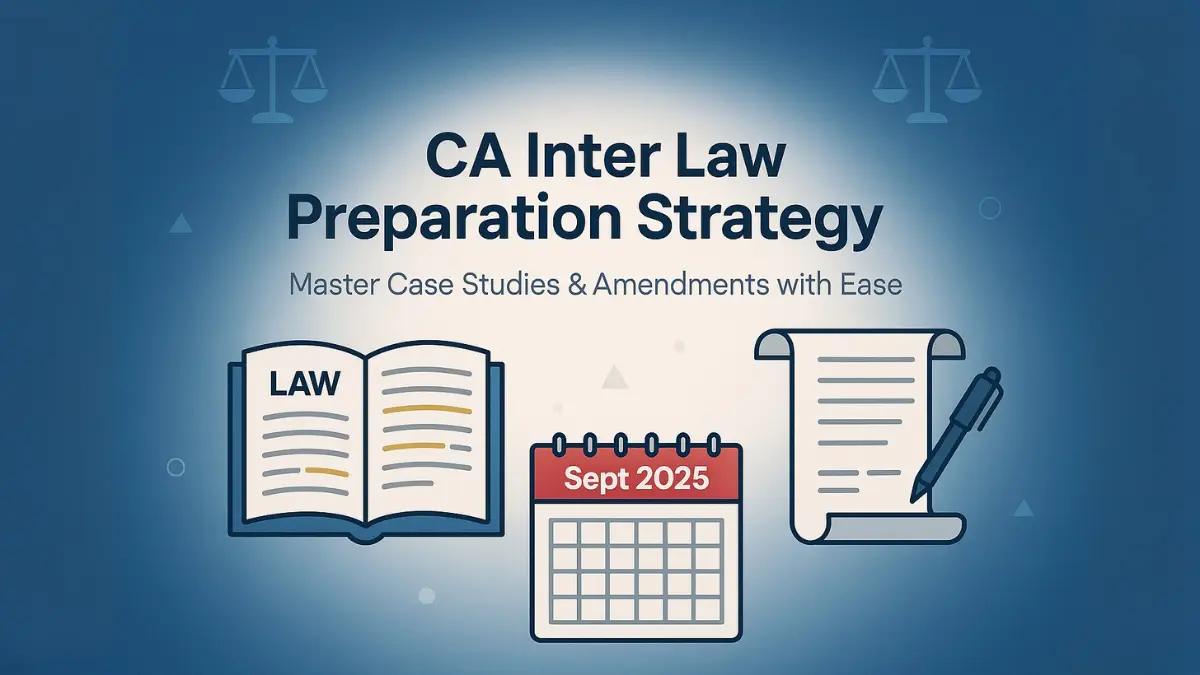CA Inter Law can feel heavy at first. A lot is required to be remembered, and sometimes it seems that every rule is followed by an exception. But here’s the good news: CA Inter Law is scoring if you plan it well. Each chapter should be thought of as a small story. When the story behind each law is understood, remembering it becomes easier.
The ICAI Board of Studies recommends keeping a daily routine for law exam. Revising a little every day is better than cramming everything at the last moment. Mock tests are your friends, they show what you know and what still confuses you. Small breaks while studying are considered equally important. It is seen as okay if tea is had, a walk is taken, or a step away is made. In this way, the mind is kept fresh and made ready to absorb more.
You can also connect the CA Inter laws to real-life examples. For instance, when studying company directors’ responsibilities, think about a company in the news. Relating abstract rules to real cases makes them easier to recall during exams.
Understanding the CA Inter Law Syllabus
CA Inter Law is divided into two main sections:
- Company Law – about 70 marks
- Other Laws – about 30 marks
Other Laws include the Contract Act, Negotiable Instruments Act, Sale of Goods Act, and similar topics. Each has a different weight, and the examiner expects you to answer logically, clearly, and neatly.
The paper format is:
- MCQs: around 30 marks
- Descriptive/long questions: 70 marks
Typically, you will have one big question and then three out of four additional questions. It’s important to understand that clarity matters more than length. Writing neat, organized answers earns marks even if you’re unsure about a small point.
A simple way to plan is:
| Section | Marks | Study Tip |
| Company Law | 70 | Focus on concepts and sections |
| Other Laws | 30 | Practice short answer questions and examples |
By knowing this split in CA Inter Law, time is allocated efficiently and last-minute panic is avoided.
How to Read and Interpret Amendments in CA Inter Law
Law keeps changing. Every year, ICAI releases amendments, and your law syllabus updates accordingly. New rules might involve companies, contracts, or negotiable instruments. These updates can be confusing, but they carry marks, so they can’t be ignored.
Simple habits to follow:
- Highlight changes clearly in your notes.
- Make one small note per change, mentioning the section, the new rule, and a quick example.
- Revise CA Inter Law amendments regularly so they stick in your memory.
For example, a new amendment might change the minimum number of directors in a company. Don’t just memorize it. Visualize it: imagine a board meeting, count the directors, and see what difference the law makes. This method works better than reading repeatedly.
Mastering Case Studies
Case studies in law are often the most challenging part for students. They test whether you can apply the law, not just memorize it. ICAI provides sample case studies, and practicing them regularly is crucial.
A strong answer has four parts:
- Intro – Explain what the question is about and mention the relevant law.
- Law – Briefly explain the rule or section.
- Apply – Connect the law to the facts in the case.
- Conclusion – Give a short, clear answer.
Ask yourself while practicing:
- What law fits this situation?
- How do the facts match the law?
- What result should I clearly write?
Example:
Imagine a company fails to file its annual returns. Apply the Companies Act section on penalties for non-compliance. Show how the facts meet the rule and conclude with the fine or action required. Practicing this way makes you confident during law exam.
Effective Study Strategies
Here are tips to study smart and remember more for CA Inter Law:
- Keep sentences short. Avoid long, complicated lines. It’s easier to revise.
- Use simple words. “Help” is better than “facilitate.”
- Make flowcharts and tables. ICAI notes often have them, and they help you recall rules faster.
Practical tips:
- A topic should be read today, revised tomorrow, and reviewed again next week. Repetition is considered the key.
- A personal summary should be written, and important points should be highlighted with colors or small diagrams.
- Time should be kept track of. Too long should not be spent on one topic, and balance should be maintained.
Using Past Papers and RTPs
Past papers, RTPs, and MTPs are essential tools for CA Inter Law preparation. They help you understand how ICAI frames questions and which topics are repeated.
Practice Plan:
| What to Practice | Why It Helps |
| Past 3–5 Years Papers | See case study patterns |
| RTPs & MTPs | Learn ICAI style and trends |
| Amendments + Practice Qs | Use new law confidently in answers |
Simulating exam conditions while practicing CA Inter Law questions also improves your speed and confidence.
Conclusion: Cracking CA Inter Law with Confidence
CA Inter Law is completely manageable if you stick to a plan. Focus on:
- Understanding the CA Inter Law syllabus and mark weightage.
- Staying updated with amendments.
- Practicing case studies regularly.
- Using past papers and RTPs to improve speed and clarity.
Make your preparation personal. Share little stories from your prep:
- Did a tricky CA Inter Law amendment confuse you at first but became easy after writing it down?
- Which case study made you proud when you solved it correctly?
Small stories are made to make learning real, and CA Inter Law concepts are remembered better through them. Consistency, revision, and self-confidence are seen as the keys. The schedule should be followed, calmness should be maintained, and CA Inter Law will be mastered step by step.









